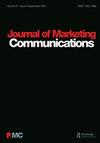ELM、警告标签、产品形式、不可提及的主题广告、移动广告:未来研究和测试替代场景的范围
Q1 Business, Management and Accounting
引用次数: 0
摘要
这期发表了五篇论文。Hedli和Zourigg的第一篇论文比较和对比了两个与态度改变和说服有关的模型——经常被引用的精细化可能性模型和单一模型——这两种模型多少有些对抗性。唉,这两者都受到概念和经验的限制。态度变化是用双重过程还是单一过程来更好地解释的问题,通过一场强有力的、详细的、发人深省的辩论来解决。最后,作者得出结论,支持ELM作为该领域的主要贡献。也就是说,我和相关文献都在等待一个对可能性模型的有力辩护,特别是一个对说服在现代环境中是如何发生的双重解释的实证支持。看看这个空间。Phua和Lim专注于通过社交媒体为电子烟品牌做广告的现代做法,这种做法有些可疑,通过一系列完善的实验情况,可以明显地“降低风险”、“更健康、更有规律”和“使用电子烟戒烟”。在社交媒体上使用警告标签和名人代言似乎在一定程度上改善了积极广告宣传的潜在影响。与第一篇论文一样,就监管机构的角色及其作用而言,未来研究的大门是敞开的。对于未来的一些作者来说,面对政府在纳税申报方面持续的巨额收入,这些观点是否有一定意义,这将是一个有趣的问题。因此,彻底禁止吸传统烟或电子烟是最不可能的,尽管吸烟者在晚年的医疗成本很高。Amirkhizi、Pouralebi和Anzabi的这篇论文处理了营销传播术语中一个相当不寻常的主题——视觉形式——以帮助设计师和分析师设计产品,以适应不同文化背景下用户的形式偏好。可以预见,不同的文化对产品形式产生不同的感受和反应,这似乎为设计师在设计产品和包装时考虑消费者或用户的感知提供了重要的希望。这在经济上是否可行还有待观察。看到产品制造商和包装制造商尝试与产品购买相关的形式将是一件有趣的事情。Yoon, Kim和Choi解决了一个曾经在市场营销和营销传播术语中几乎无法提及的问题,即如何教育感染HPV的成年人寻求预防和治疗,而不是忍受疾病,或者更糟——感染他人。接种疫苗是最容易的,但当今世界许多公民仍未接种疫苗。正如她的幽默所证明的那样,《STD营销传播杂志》2023年第29卷第1期。5,431 - 432 https://doi.org/10.1080/13527266.2023.2223808本文章由计算机程序翻译,如有差异,请以英文原文为准。
ELM, warning labels, product form(s), unmentionable subjects ads, mobile advertising: Scope for future research and testing alternate scenarios
This issue publishes five papers. The first paper by Hedli and Zourigg compares and contrasts – somewhat confrontationally, two models relating to attitudinal change and persuasion – the much-cited Elaboration Likelihood Model and the Unimodel. Both – alas – suffer from conceptual and empirical limitations. The question of whether attitudinal change is better explained by a dual or single process is tackled via a robust, detailed and though-provoking polemic. In the end, the authors conclude in favor of the ELM as the major contribution in the field. That said, I and indeed the literature await a robust defense of the elaboration likelihood model, and specifically one that underpins empirically the notion of a dual explanation as to how persuasion does occur in a modern context. Watch this space. Phua and Lim focus on the somewhat dubious modern practice of advertising electronic cigarette brands via social media leading to apparently ‘reduced risk’, ‘heathier and regular’ and ‘quit smoking using e-cigarettes’ via a well-developed series of experimental situations. Use of warning labels together with celebrity endorsements via social media seems to ameliorate to some degree the potential effects of positive advertising claims. As with the first paper, the door of future research is left well open in terms of the role of regulatory agencies and their role. It would be interesting for some future authors to tackle the subject of whether these points are mooted somewhat in the face of ongoing huge revenues to government in terms of tax returns. Thus, an outright ban on smoking either of traditional or e-cigarettes is most unlikely despite significant health care costs for smokers in later life. The paper by Amirkhizi, Pouralebi and Anzabi tackles a fairly unusual subject in marketing communication terms – that of visual form – to help designers and analysts design products to suit user formal preferences in different cultural contexts. As may well be anticipated different cultures produce differing feelings and reactions with regard to product forms and would appear to offer significant promise for designers to take consumer or user perceptions into considering when designing products and indeed packaging. Whether this is economically feasible or not remains to be seen. It would be interesting to see examples of product manufacturers and indeed package makers to experiment with form relative to product purchase. Yoon, Kim and Choi tackle tackle one of what used to be an almost unmentionable subject in marketing and marketing communication terms, in terms of how to educate adults who are infected with HPV to seek out prevention and treatment, rather than suffering with an illness, or worse – infecting others. Vaccination is the easiest, but many citizens in today’s world remain unvaccinated. As is evidenced her humor, STD JOURNAL OF MARKETING COMMUNICATIONS 2023, VOL. 29, NO. 5, 431–432 https://doi.org/10.1080/13527266.2023.2223808
求助全文
通过发布文献求助,成功后即可免费获取论文全文。
去求助
来源期刊

Journal of Marketing Communications
Business, Management and Accounting-Business and International Management
CiteScore
7.70
自引率
0.00%
发文量
44
期刊介绍:
The Journal of Marketing Communications is a double-blind peer-reviewed journal devoted to publishing research papers and information concerning all aspects of marketing and corporate communication, branding both corporate and product-related, and promotion management. It is a channel for discussing issues such customer relationship management, integrated marketing communication, together with behavioural foundations of marketing communications and promotion management. The Journal will also consider papers in internal marketing and in the corporate communications domain.
 求助内容:
求助内容: 应助结果提醒方式:
应助结果提醒方式:


